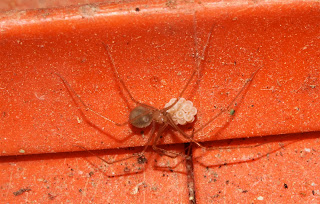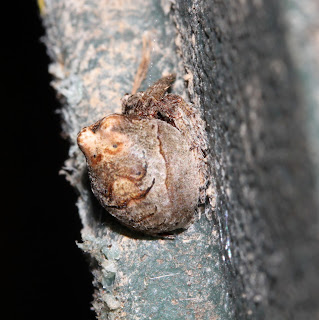They're very cute, like characters in Winnie the Pooh. If you notice, the black spots on the the back each have half a dozen red warts in them, which is the sign that they are Fowler's, and not some other species of toad. I can't help wondering what effect they are going to have on the small wolf spiders in the yard, each of which would make a nice mouthful for them. [Update: I went out on a night op last night, making a round of the garden, and I only saw about a dozen pairs of eyes looking back at me. It was as if the yard had been vacuumed. Maybe I need to devise a toad vacuum!]
Also in the yard right now are a number of Five-lined Skinks. Here is a male with his reddish jaws. The jaws are not as massive and muscular as those on the larger Broadhead Skink. But perhaps to compensate, these retain their blue tails into adulthood. Both Five-lined and Broadhead hatch from the egg with brilliant blue tails, which they flirt around, drawing the attention of predators, so that the losable and regrowable tail is seized while the front end runs away. When the Broadhead Skink matures, it loses it's blue tail. It is so burly and has such a powerful bite it probably doesn't need to rely on deception.
Not in the yard but not far away in the Joneboro Nature Center we saw this more colorful Prairie Racerunner. Like us these days he is covered with tiny orange chiggers. And a little bit farther away, on Hatchie Coon Island we saw this also colorful reptile, a slow-moving Mud Snake.
But now let's get back to small things, which should be our proper subject. In fact as compensation I'll bring up the smallest things we have seen. Here for instance at 1-2 mm long is a False Scorpion, false I presume because he has no venomous tail. They crawl around in the leaf litter and seize springtails with their claws, but from time to time they also climb to the top of flowers and when bees or butterflies land near them they hop on for a free ride to the next flower.
We had seen False Scorpions here before (not recently), so we weren't surprised. But we also found a brand new tiny thing that we had no idea lived here. I have mentioned before that my study is almost filled with Longbodied Cellar Spiders, sort of a daddylonglegs that will gradually fill all the space in a room with cobweb if you don't keep them trimmed back. I had read that there are other species of cellar spider, but most seemed to be found in the desert southwest. It took Cheryl's sharp eyes to realize there was indeed another species of cellar spider around, and in fact there was a population of them living right in the garage that my study is located in. There is a reason I hadn't noticed them: They are only about 2 mm long, which is to say, virtually invisible. They are called Shortbodied Cellar Spiders. They have the disproportionately long legs of the common Longbodied Cellar Spider that I live with daily, but they are still very close to being invisible. They are so tiny they are difficult to photograph. But the moment we got a good look at them we knew they were cellar spiders. You see, when the female cellar spider lays eggs, she puts them into a silk purse that she carries everywhere with her. She carries them in her jaws, and what is so distinctive about them is, she weaves her purse out of so few strands you can barely see the the purse, so the eggs are in plain sight. Here is a picture of our familiar Longbodied Cellar Spider carrying her eggs, and here is a picture (hugely enlarged) of our new Shortbodied Cellar Spider, also carrying her eggs in that purely cellar spider way.
Our usual cellar spider has the normal spider complement of eight eyes, but the tiny cellar spider only has six eyes. Unlike the Brown Recluse and the Spitting Spider which have six eyes (I have showed you pictures of them in this blog: They have three double eyes arranged in a triangle), the Shortbodied Cellar Spider has two triple eyes, the eyes appearing on each side of the head like "normal" eyes. You can see it in these pictures.
What else is new around here? Well, we always have good numbers of fireflies in our yard (all you have to do is have grass in your yard that you don't mow very much and of course never spray), and we know that the flashing of lights is mainly to attract males and females of the right species to each other, and when they meet they mate. But we had never thought much about the next step. But what seems to be common in our yard this year, and I don't know why we have never seen it before, is that we have female fireflies walking around on the ground, and they are walking because their abdomens are so bloated and distended with eggs that they can't get off the ground. Here's an example of one with its abdomen almost double its normal length (usually the abdomen does not extend beyond the ends of the elytra).
There's a smallish spider common in woodlands here called a Filmy Dome Spider. The web is characteristic: It has a tangle of supporting lines, and in the middle is a rising dome like an inverted bowl. I had tried in the past photographing it against a dark background, hoping that would bring out the shape, but webs (unless they are covered with dew) don't show up very well in photographs) and I only got pictures with the vague suggestion of a dome in the midst of all the other lines. But the other day I was up at dawn and in the backyard there was a dome web between me and the rising sun, and the sun lit up every strand, and I finally got a fairly satisfactory picture.
Now we come to the spider of the month: the Asterisk Spider, so named because it makes a web of single strands sent out in all directions around it, so that it looks somewhat like an asterisk. I have never found the web, though I continue to look hard for it. The spider itself is impossible to find out in the woods (you will see why shortly), but I found this one hiding inside my empty garbage can. After I had photographed him, I placed him on a bush in our yard hoping he would be induced to make his web, and he immediately did his disappearing trick right before our eyes, resembling so closely a bump on a twig that if we had not seen him do it, we wouldn't have believed it. Unfortunately instead of making a web overnight, he simply left. But we got some wonderful bump-on-a-twig pictures.















No comments:
Post a Comment